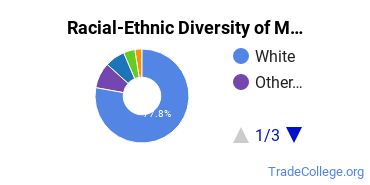Mechanics & Repairers
Featured schools near , edit
Types of Degrees Mechanics & Repairers Majors Are Getting
The following table lists how many mechanics & repairers graduations there were in 2021-2022 for each degree level.
| Education Level | Number of Grads |
|---|---|
| Associate Degree | 178 |
| Undergraduate Certificate | 122 |
| Basic Certificate | 47 |
What Mechanics & Repairers Majors Need to Know
In an O*NET survey, mechanical repair majors were asked to rate what knowledge areas, skills, and abilities were important in their occupations. These answers were weighted on a scale of 1 to 5 with 5 being the most important.
Knowledge Areas for Mechanical Repair Majors
This major prepares you for careers in which these knowledge areas are important:

- Mechanical - Knowledge of machines and tools, including their designs, uses, repair, and maintenance.
- Customer and Personal Service - Knowledge of principles and processes for providing customer and personal services. This includes customer needs assessment, meeting quality standards for services, and evaluation of customer satisfaction.
- English Language - Knowledge of the structure and content of the English language including the meaning and spelling of words, rules of composition, and grammar.
- Computers and Electronics - Knowledge of circuit boards, processors, chips, electronic equipment, and computer hardware and software, including applications and programming.
- Mathematics - Knowledge of arithmetic, algebra, geometry, calculus, statistics, and their applications.
Skills for Mechanical Repair Majors
When studying mechanical repair, you’ll learn many skills that will help you be successful in a wide range of jobs - even those that do not require a degree in the field. The following is a list of some of the most common skills needed for careers associated with this major:

- Repairing - Repairing machines or systems using the needed tools.
- Critical Thinking - Using logic and reasoning to identify the strengths and weaknesses of alternative solutions, conclusions or approaches to problems.
- Troubleshooting - Determining causes of operating errors and deciding what to do about it.
- Operation Monitoring - Watching gauges, dials, or other indicators to make sure a machine is working properly.
- Quality Control Analysis - Conducting tests and inspections of products, services, or processes to evaluate quality or performance.
Who Is Getting an Associate’s Degree in Mechanics & Repairers?
Racial-Ethnic Diversity
At the countrywide level, the racial-ethnic distribution of mechanical repair majors is as follows:

| Race/Ethnicity | Number of Grads |
|---|---|
| Asian | 3 |
| Black or African American | 11 |
| Hispanic or Latino | 6 |
| White | 142 |
| International Students | 0 |
| Other Races/Ethnicities | 16 |
Online Mechanics & Repairers Programs
The following table lists the number of programs by degree level, along with how many schools offered online courses in the field.
| Degree Level | Colleges Offering Programs | Colleges Offering Online Classes |
|---|---|---|
| Certificate (Less Than 1 Year) | 0 | 0 |
| Certificate (1-2 years) | 7 | 0 |
| Certificate (2-4 Years) | 0 | 0 |
| Associate’s Degree | 12 | 1 |
| Bachelor’s Degree | 0 | 0 |
| Post-Baccalaureate | 0 | 0 |
| Master’s Degree | 0 | 0 |
| Post-Master’s | 0 | 0 |
| Doctor’s Degree (Research) | 0 | 0 |
| Doctor’s Degree (Professional Practice) | 0 | 0 |
| Doctor’s Degree (Other) | 0 | 0 |
Explore Major by State
Alabama
California
District of Columbia
Idaho
Kansas
Maryland
Mississippi
Nevada
New York
Oklahoma
South Carolina
Utah
West Virginia
Alaska
Colorado
Florida
Illinois
Kentucky
Massachusetts
Missouri
New Hampshire
North Carolina
Oregon
South Dakota
Vermont
Wisconsin
Trades Related to Mechanics & Repairers
You may also be interested in one of the following majors related to mechanical repair.
| Major | Number of Grads |
|---|---|
| Vehicle Maintenance & Repair | 63,451 |
| Heating, Air Conditioning, Ventilation & Refrigeration | 21,891 |
| Heavy/Industrial Equipment Maintenance | 8,446 |
| Electronics Maintenance & Repair | 8,127 |
| Precision Systems Maintenance | 2,185 |
| Mechanic & Repair Tech (Other) | 1,184 |
| Energy Systems Maintenance and Repair Technologies. | 110 |
References
*The racial-ethnic minorities count is calculated by taking the total number of students and subtracting white students, international students, and students whose race/ethnicity was unknown. This number is then divided by the total number of students at the school to obtain the racial-ethnic minorities percentage.
- College Factual
- College Scorecard
- National Center for Education Statistics
- O*NET Online
- U.S. Bureau of Labor Statistics
- Usual Weekly Earnings of Wage and Salary Workers First Quarter 2020
- Image Credit: By Alfred Palmer under License
More about our data sources and methodologies.
Featured Schools
 Request Info
Request Info
|
Southern New Hampshire University You have goals. Southern New Hampshire University can help you get there. Whether you need a bachelor's degree to get into a career or want a master's degree to move up in your current career, SNHU has an online program for you. Find your degree from over 200 online programs. Learn More > |
